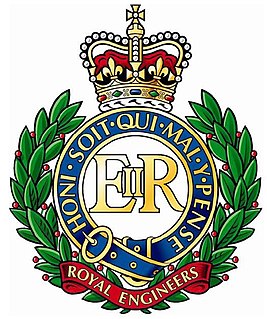 W
W35 Engineer Regiment is a unit of the British Army’s Royal Engineers under operational command (OPCOM) 8th Engineer Brigade, Force Troops Command. The Unit provided close support engineering under operational control (OPCON) to 20th Armoured Infantry Brigade. It is now an Explosive Ordnance Disposal and Search unit. It is located in Wimbish.
 W
WThe 36th Engineer Regiment is a regiment of the Corps of Royal Engineers within the British Army. The regiment trace their history back to before World War II as the 36th Army Engineer Regiment. The regiment today is a general support engineer regiment provided force support within 12 Engineer Group.
 W
WThe Corps of Royal Engineers, usually just called the Royal Engineers (RE), and commonly known as the Sappers, is a corps of the British Army. It provides military engineering and other technical support to the British Armed Forces and is headed by the Chief Royal Engineer. The Regimental Headquarters and the Royal School of Military Engineering are in Chatham in Kent, England. The corps is divided into several regiments, barracked at various places in the United Kingdom and around the world.
 W
WThe East Lancashire Royal Engineers was a Volunteer unit of Britain's Royal Engineers raised in Manchester in 1901. It became the engineer component of the 42nd Division of the Territorial Force, seeing service in Egypt, at Gallipoli and on the Western Front during World War I. In World War II it was in the Dunkirk evacuation with 42nd Division, and then converted to the armoured assault engineer role ('Funnies') in 79th Armoured Division in North West Europe. Its duplicate unit served in Tunisia and Italy. The unit continues today as part of 75 Engineer Regiment in the Army Reserve.
 W
WThe East Lancashire Royal Engineers was a Volunteer unit of Britain's Royal Engineers raised in Manchester in 1901. It became the engineer component of the 42nd Division of the Territorial Force, seeing service in Egypt, at Gallipoli and on the Western Front during World War I. In World War II it was in the Dunkirk evacuation with 42nd Division, and then converted to the armoured assault engineer role ('Funnies') in 79th Armoured Division in North West Europe. Its duplicate unit served in Tunisia and Italy. The unit continues today as part of 75 Engineer Regiment in the Army Reserve.
 W
W101 Engineer Regiment is a regiment of the British Army's Royal Engineers. Under Army 2020 Refine, the regiment moved from a hybrid regiment to a reserve EOD&S regiment with the regimental headquarters established in Catford. It is part of 29th Group, 8 Engineer Brigade. The Honorary Colonel of the regiment is Col Jools Holland.
 W
WThe 1st Middlesex Engineers was the senior engineer unit of Britain's Volunteer Force, raised in 1860 and originally recruited from the South Kensington Museum. It provided Royal Engineers (RE) units to the 47th Division, the 47th (London) Infantry Division, the 56th (London) Divisions, and the 60th Division during both World Wars. The engineers served on the First World War's Western Front from 1915 to 1918, and in a number of theatres during the Second World War. It also served in the postwar Territorial Army, until 1967.
 W
WThe 1st Middlesex Engineers was the senior engineer unit of Britain's Volunteer Force, raised in 1860 and originally recruited from the South Kensington Museum. It provided Royal Engineers (RE) units to the 47th Division, the 47th (London) Infantry Division, the 56th (London) Divisions, and the 60th Division during both World Wars. The engineers served on the First World War's Western Front from 1915 to 1918, and in a number of theatres during the Second World War. It also served in the postwar Territorial Army, until 1967.
 W
WThe Tower Hamlets Engineers was a Volunteer unit of the British Royal Engineers (RE) based in East London. Raised in 1868, it provided engineers for two London infantry divisions of the Territorial Force during World War I. In World War II it operated as an RE headquarters, particularly on D-Day and at the Rhine Crossing, while its subordinate companies served in a number of campaigns, including the Siege of Tobruk and with the Chindits. Its successor unit continues to serve in today's Army Reserve.
 W
WThe 1st Hampshire Engineer Volunteer Corps was first formed in 1862 and then reformed in 1891 with special responsibility for the port defences of the South Coast of England. It carried out this role during World War I, as well as forming field units that served on the Western Front and at Salonika. Before the outbreak of World War II it formed an air defence regiment that saw service during The Blitz and field companies that fought in the Western Desert and Italy, The unit continued in the postwar Territorial Army before finally disbanding in 1967.
 W
WThe 1st Hampshire Engineer Volunteer Corps was first formed in 1862 and then reformed in 1891 with special responsibility for the port defences of the South Coast of England. It carried out this role during World War I, as well as forming field units that served on the Western Front and at Salonika. Before the outbreak of World War II it formed an air defence regiment that saw service during The Blitz and field companies that fought in the Western Desert and Italy, The unit continued in the postwar Territorial Army before finally disbanding in 1967.
 W
WThe 1st Devonshire Engineer Volunteer Corps, later the Devonshire Fortress Royal Engineers, was a volunteer unit of Britain's Royal Engineers whose history dated back to 1862. The unit helped to defend the vital naval base of Plymouth, and supplied detachments for service in the field in both World Wars. During the North African campaign in World War II, the unit's sappers distinguished themselves in bridging the Nile and clearing minefields during and after El Alamein. Their successors served on the postwar Territorial Army until 1969.
 W
WThe 1st Devonshire Engineer Volunteer Corps, later the Devonshire Fortress Royal Engineers, was a volunteer unit of Britain's Royal Engineers whose history dated back to 1862. The unit helped to defend the vital naval base of Plymouth, and supplied detachments for service in the field in both World Wars. During the North African campaign in World War II, the unit's sappers distinguished themselves in bridging the Nile and clearing minefields during and after El Alamein. Their successors served on the postwar Territorial Army until 1969.
 W
WThe 1st Sussex Engineers was a Volunteer unit of Britain's Royal Engineers raised in Eastbourne in 1890. It became the engineer component of the 44th Division of the Territorial Force, but its units saw action with Regular Army formations on the Western Front, at Salonika and in Italy during World War I, and in North Russia and Turkey after the war ended. During World War II its units were in the Battle of France and at Alamein, in Sicily, on D Day and the subsequent campaign in North West Europe, including the Rhine crossing. Detached companies fought in Tunisia, Italy, and Burma, where one was involved in the decisive Battle of Kohima and the assault crossing of the Irrawaddy. The unit continued in the postwar Territorial Army until 1967.
 W
WThe Kent Fortress Royal Engineers (KFRE) was a volunteer Territorial unit of the British Army that saw service in both World Wars. They are notable for their successful actions in May 1940, when they destroyed substantial oil stocks and installations just ahead of the German advance, and in August 1944 during the assault crossing of the River Seine.
 W
WThe 1st Middlesex Engineers was the senior engineer unit of Britain's Volunteer Force, raised in 1860 and originally recruited from the South Kensington Museum. It provided Royal Engineers (RE) units to the 47th Division, the 47th (London) Infantry Division, the 56th (London) Divisions, and the 60th Division during both World Wars. The engineers served on the First World War's Western Front from 1915 to 1918, and in a number of theatres during the Second World War. It also served in the postwar Territorial Army, until 1967.
 W
WThe 1st Middlesex Engineers was the senior engineer unit of Britain's Volunteer Force, raised in 1860 and originally recruited from the South Kensington Museum. It provided Royal Engineers (RE) units to the 47th Division, the 47th (London) Infantry Division, the 56th (London) Divisions, and the 60th Division during both World Wars. The engineers served on the First World War's Western Front from 1915 to 1918, and in a number of theatres during the Second World War. It also served in the postwar Territorial Army, until 1967.
 W
WThe East Lancashire Royal Engineers was a Volunteer unit of Britain's Royal Engineers raised in Manchester in 1901. It became the engineer component of the 42nd Division of the Territorial Force, seeing service in Egypt, at Gallipoli and on the Western Front during World War I. In World War II it was in the Dunkirk evacuation with 42nd Division, and then converted to the armoured assault engineer role ('Funnies') in 79th Armoured Division in North West Europe. Its duplicate unit served in Tunisia and Italy. The unit continues today as part of 75 Engineer Regiment in the Army Reserve.
 W
WThe Dundee Fortress Royal Engineers was a Scottish volunteer unit of the British Army formed in 1908. Its main role was the defence of the harbours and shipyards on the River Tay, but it also provided a detachment that saw active service in North Russia at the end of World War I. In the 1930s, it was turned into an air defence unit, in which role it served in World War II. A brief postwar revival ended in disbandment in 1950.
 W
WThe 1st Durham Engineers, later Durham Fortress Engineers, was a Volunteer unit of the British Army's Royal Engineers. First founded in 1868 it was sometimes united with the Tyne Electrical Engineers, at other times it formed an independent unit. Although its main role was defence of the North East Coast of England, the unit sent detachments on active service to the Suakin Expedition, the Second Boer War, and the Western Front and Italy during the First World War.
 W
W140 Corps Engineer Regiment was a short-lived Territorial Army (TA) unit of the Royal Engineers based in the North Midlands of England during the 1960s.
 W
WThe Royal Monmouthshire Royal Engineers (Militia) is the most senior regiment in the British Army Reserve, having given continuous loyal service to the crown since 1539. It is part of the reserve forces, and is the only remaining Militia unit in the British Army.